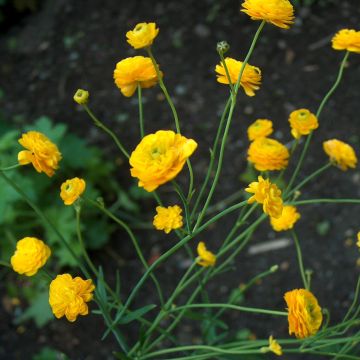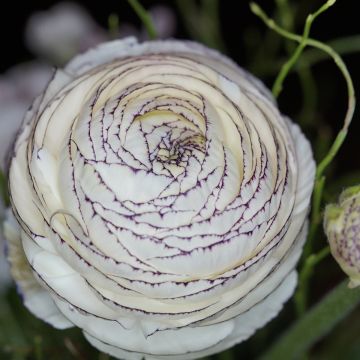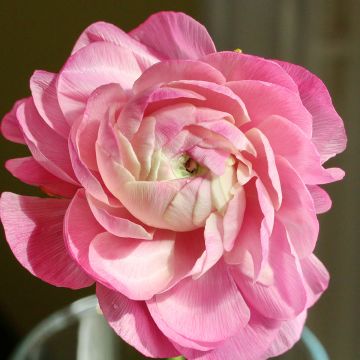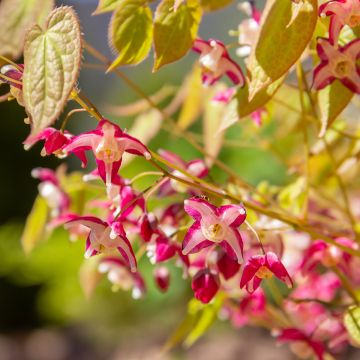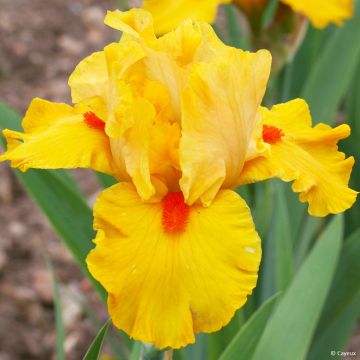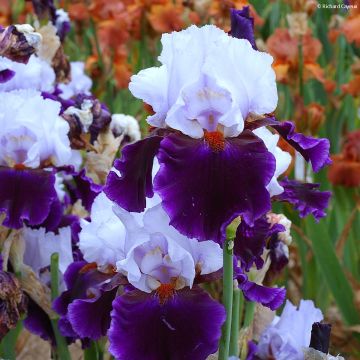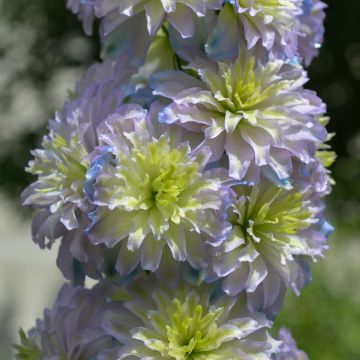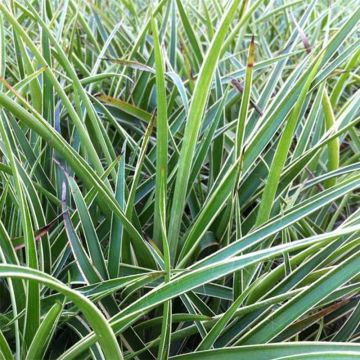

Ranunculus ficaria Brazen Hussy - Lesser Celandine
Ranunculus ficaria Brazen Hussy - Lesser Celandine
Ranunculus ficaria Brazen Hussy
Lesser celandine 'Brazen Hussy'
packaging and delivery: as always great! This young plant bloomed and then disappeared, but it's not its fault. Gorgeous dark foliage that contrasts well with the yellow flower - I will order again :-)
Estelle, 26/06/2020
Why not try an alternative variety in stock?
View all →This plant carries a 12 months recovery warranty
More information
We guarantee the quality of our plants for a full growing cycle, and will replace at our expense any plant that fails to recover under normal climatic and planting conditions.
From €5.90 for pickup delivery and €6.90 for home delivery
Express home delivery from €8.90.

Does this plant fit my garden?
Set up your Plantfit profile →
Description
Ranunculus ficaria 'Brazen Hussy', discovered in Great Dixter in the garden of the famous landscape designer Christopher Lloyd, is an improved version of the lesser celandine, which is very common in cool undergrowth. This small perennial produces light and bright yellow flowers from early spring. They truly sparkle like buttercups. They emerge from shiny dark foliage, almost at ground level. This variety gradually spreads, forming beautiful colonies in slightly cool soils, even under the cover of deciduous trees to which it perfectly tolerates root competition. A delightful ground cover, perfectly paired with the blue flowers of hepaticas, or Anemone blanda.
Ranunculus ficaria, also known as Ficaria verna, Ficaria ranunculoides, or simply as lesser celandine, belongs to the Ranunculaceae family, just like our famous buttercup. It is native to Europe, western Asia and North Africa, and has been introduced to North America where it has sometimes become invasive. It can be found in light deciduous forests, where it blooms early in spring before the trees' leaves develop, at the edge of forests, and in moist and wet places like the banks of rivers. It also likes meadows, embankments, and hedges, where it grows up to 1600m (5249ft) altitude, always in relatively moist soil.
It is a small perennial plant with brown and swollen roots forming small tubers. They ensure its vegetative multiplication and allow it to colonise space quite quickly. Its above-ground vegetation disappears after flowering, which corresponds to its resting period. The lesser celandine spends the first part of winter in bud form and develops its new leaves before flowering, in January-February depending on the climate.
The cultivar 'Brazen Hussy' distinguishes itself with its very dark foliage. Forming a small tuft 5cm (2in) tall, this lesser celandine spreads quite rapidly over at least 30cm (12in) of ground. Its foliage is composed of heart-shaped leaves, 4 to 9cm (2 to 4in) wide. They are thick and shiny, with a colour that is a mix of purple-violet, dark brown and very dark green. Flowering occurs from March to May, depending on the climate, sometimes as early as February. Clumps of foliage emerge from peduncles 15 to 20cm (6 to 8in) tall, each bearing a solitary flower measuring 3 to 4cm (1 to 2in) in diameter, composed of 6 to 12 oval and elongated petals. The blooms are well separated, and display a light and shiny yellow on the top. The flowers open in the morning and close in the evening, even in cloudy or rainy weather. Numerous yellow stamens and carpels are located at the centre. The lesser celandine reproduces poorly through spontaneous sowing. Before the vegetation disappears, the plant develops bulblets in the axils of the leaves. They detach along with a small piece of stem with a bud. This tiny seedling falls to the ground and takes root, ensuring the multiplication of the lesser celandine.
Being very easy to grow in ordinary soil, 'Brazen Hussy' has good hardiness (-20°C (-4°F)). It prefers moist soils, even marshy ones, but also adapts easily to any good soil that is not too dry. It can also be grown in pots to adorn a patio or balcony, starting from late winter. Plant it at the edge of a grove or in a wildflower bed, in partial shade or in full sun, alongside hepaticas (Hepatica nobilis), lungworts, brunneras, or blue forget-me-nots, with their complementary colours. It is also a good perennial for moist banks, even in partial shade, next to Rodgersias pinnata 'Chocolate Wings' or Actaea simplex 'Brunette', with their purple foliage.
Report an error about the product description
Ranunculus ficaria Brazen Hussy - Lesser Celandine in pictures


Flowering
Foliage
Plant habit
Botanical data
Ranunculus
ficaria
Brazen Hussy
Ranunculaceae
Lesser celandine 'Brazen Hussy'
Cultivar or hybrid
Other Ranunculus - Buttercup
Planting and care
It thrives in any ordinary, moist to wet soil, even clayey soil. It appreciates sunny exposures but will develop in partial shade or under deciduous trees. It tolerates root competition well. It requires no maintenance.
Planting period
Intended location
Care
-
, onOrder confirmed
Reply from on Promesse de fleurs
Spring flowering perennials
Haven't found what you were looking for?
Hardiness is the lowest winter temperature a plant can endure without suffering serious damage or even dying. However, hardiness is affected by location (a sheltered area, such as a patio), protection (winter cover) and soil type (hardiness is improved by well-drained soil).

Photo Sharing Terms & Conditions
In order to encourage gardeners to interact and share their experiences, Promesse de fleurs offers various media enabling content to be uploaded onto its Site - in particular via the ‘Photo sharing’ module.
The User agrees to refrain from:
- Posting any content that is illegal, prejudicial, insulting, racist, inciteful to hatred, revisionist, contrary to public decency, that infringes on privacy or on the privacy rights of third parties, in particular the publicity rights of persons and goods, intellectual property rights, or the right to privacy.
- Submitting content on behalf of a third party;
- Impersonate the identity of a third party and/or publish any personal information about a third party;
In general, the User undertakes to refrain from any unethical behaviour.
All Content (in particular text, comments, files, images, photos, videos, creative works, etc.), which may be subject to property or intellectual property rights, image or other private rights, shall remain the property of the User, subject to the limited rights granted by the terms of the licence granted by Promesse de fleurs as stated below. Users are at liberty to publish or not to publish such Content on the Site, notably via the ‘Photo Sharing’ facility, and accept that this Content shall be made public and freely accessible, notably on the Internet.
Users further acknowledge, undertake to have ,and guarantee that they hold all necessary rights and permissions to publish such material on the Site, in particular with regard to the legislation in force pertaining to any privacy, property, intellectual property, image, or contractual rights, or rights of any other nature. By publishing such Content on the Site, Users acknowledge accepting full liability as publishers of the Content within the meaning of the law, and grant Promesse de fleurs, free of charge, an inclusive, worldwide licence for the said Content for the entire duration of its publication, including all reproduction, representation, up/downloading, displaying, performing, transmission, and storage rights.
Users also grant permission for their name to be linked to the Content and accept that this link may not always be made available.
By engaging in posting material, Users consent to their Content becoming automatically accessible on the Internet, in particular on other sites and/or blogs and/or web pages of the Promesse de fleurs site, including in particular social pages and the Promesse de fleurs catalogue.
Users may secure the removal of entrusted content free of charge by issuing a simple request via our contact form.
The flowering period indicated on our website applies to countries and regions located in USDA zone 8 (France, the United Kingdom, Ireland, the Netherlands, etc.)
It will vary according to where you live:
- In zones 9 to 10 (Italy, Spain, Greece, etc.), flowering will occur about 2 to 4 weeks earlier.
- In zones 6 to 7 (Germany, Poland, Slovenia, and lower mountainous regions), flowering will be delayed by 2 to 3 weeks.
- In zone 5 (Central Europe, Scandinavia), blooming will be delayed by 3 to 5 weeks.
In temperate climates, pruning of spring-flowering shrubs (forsythia, spireas, etc.) should be done just after flowering.
Pruning of summer-flowering shrubs (Indian Lilac, Perovskia, etc.) can be done in winter or spring.
In cold regions as well as with frost-sensitive plants, avoid pruning too early when severe frosts may still occur.
The planting period indicated on our website applies to countries and regions located in USDA zone 8 (France, United Kingdom, Ireland, Netherlands).
It will vary according to where you live:
- In Mediterranean zones (Marseille, Madrid, Milan, etc.), autumn and winter are the best planting periods.
- In continental zones (Strasbourg, Munich, Vienna, etc.), delay planting by 2 to 3 weeks in spring and bring it forward by 2 to 4 weeks in autumn.
- In mountainous regions (the Alps, Pyrenees, Carpathians, etc.), it is best to plant in late spring (May-June) or late summer (August-September).
The harvesting period indicated on our website applies to countries and regions in USDA zone 8 (France, England, Ireland, the Netherlands).
In colder areas (Scandinavia, Poland, Austria...) fruit and vegetable harvests are likely to be delayed by 3-4 weeks.
In warmer areas (Italy, Spain, Greece, etc.), harvesting will probably take place earlier, depending on weather conditions.
The sowing periods indicated on our website apply to countries and regions within USDA Zone 8 (France, UK, Ireland, Netherlands).
In colder areas (Scandinavia, Poland, Austria...), delay any outdoor sowing by 3-4 weeks, or sow under glass.
In warmer climes (Italy, Spain, Greece, etc.), bring outdoor sowing forward by a few weeks.


































